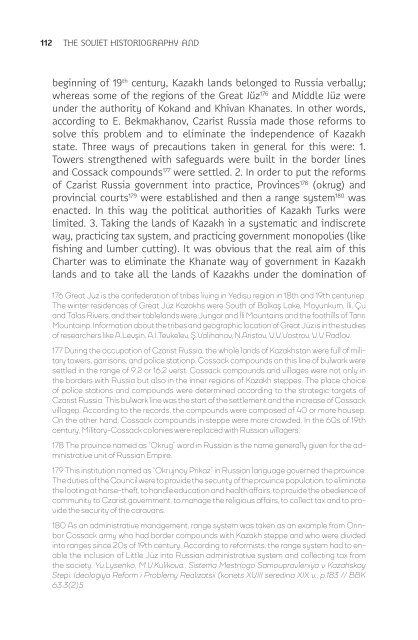THE SOVIET HISTORIOGRAPHY AND THE QUESTION OF KAZAKHSTAN’S HISTORY
SOVYET-TARIH-YAZICILIGI-ENG
SOVYET-TARIH-YAZICILIGI-ENG
You also want an ePaper? Increase the reach of your titles
YUMPU automatically turns print PDFs into web optimized ePapers that Google loves.
112<br />
<strong>THE</strong> <strong>SOVIET</strong> <strong>HISTORIOGRAPHY</strong> <strong>AND</strong><br />
beginning of 19 th century, Kazakh lands belonged to Russia verbally;<br />
whereas some of the regions of the Great Jüz 176 and Middle Jüz were<br />
under the authority of Kokand and Khivan Khanates. In other words,<br />
according to E. Bekmakhanov, Czarist Russia made those reforms to<br />
solve this problem and to eliminate the independence of Kazakh<br />
state. Three ways of precautions taken in general for this were: 1.<br />
Towers strengthened with safeguards were built in the border lines<br />
and Cossack compounds 177 were settled. 2. In order to put the reforms<br />
of Czarist Russia government into practice, Provinces 178 (okrug) and<br />
provincial courts 179 were established and then a range system 180 was<br />
enacted. In this way the political authorities of Kazakh Turks were<br />
limited. 3. Taking the lands of Kazakh in a systematic and indiscrete<br />
way, practicing tax system, and practicing government monopolies (like<br />
fishing and lumber cutting). It was obvious that the real aim of this<br />
Charter was to eliminate the Khanate way of government in Kazakh<br />
lands and to take all the lands of Kazakhs under the domination of<br />
176 Great Jüz is the confederation of tribes living in Yedisu region in 18th and 19th centuriep.<br />
The winter residences of Great Jüz Kazakhs were South of Balkaş Lake, Moyunkum, İli, Çu<br />
and Talas Rivers, and their tablelands were Jungar and İli Mountains and the foothills of Tanrı<br />
Mountainp. Information about the tribes and geographic location of Great Jüz is in the studies<br />
of researchers like A.Levşin, A.İ.Tevkelev, Ş.Valihanov, N.Aristov, V.V.Vostrov, V.V.Radlov.<br />
177 During the occupation of Czarist Russia, the whole lands of Kazakhstan were full of military<br />
towers, garrisons, and police stationp. Cossack compounds on this line of bulwark were<br />
settled in the range of 9.2 or 16.2 verst. Cossack compounds and villages were not only in<br />
the borders with Russia but also in the inner regions of Kazakh steppes. The place choice<br />
of police stations and compounds were determined according to the strategic targets of<br />
Czarist Russia. This bulwark line was the start of the settlement and the increase of Cossack<br />
villagep. According to the records, the compounds were composed of 40 or more housep.<br />
On the other hand, Cossack compounds in steppe were more crowded. In the 60s of 19th<br />
century, Military-Cossack colonies were replaced with Russian villagers.<br />
178 The province named as “Okrug” word in Russian is the name generally given for the administrative<br />
unit of Russian Empire.<br />
179 This institution named as “Okrujnoy Prikaz” in Russian language governed the province.<br />
The duties of the Council were to provide the security of the province population, to eliminate<br />
the looting at horse-theft, to handle education and health affairs, to provide the obedience of<br />
community to Czarist government, to manage the religious affairs, to collect tax and to provide<br />
the security of the caravans.<br />
180 As an administrative management, range system was taken as an example from Orınbor<br />
Cossack army who had border compounds with Kazakh steppe and who were divided<br />
into ranges since 20s of 19th century. According to reformists, the range system had to enable<br />
the inclusion of Little Jüz into Russian administrative system and collecting tax from<br />
the society. Yu.Lysenko, M.V.Kulikova., Sistema Mestnogo Samoupravleniya v Kazahskoy<br />
Stepi: İdeologiya Reform i Problemy Realizatsii (konets XVIII seredina XIX v., p.183 // BBK<br />
63.3(2)5



